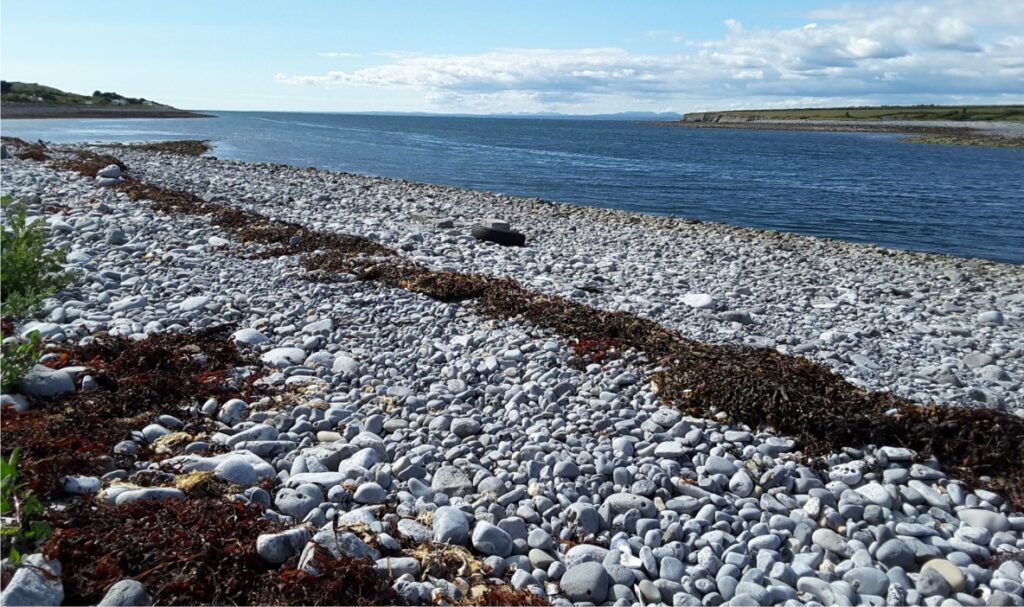

The beach next to the pub at New Quay, County Clare, Ireland, is composed of well-rounded pebbles, cobbles, and boulders that extend through the swash-backwash zone to a spring tide – storm ridge above the line of brown seaweed. Most of the clasts were sourced from local, Late Pleistocene glaciogenic deposits that in turn were derived from the nearby glacio-karsted Burrens, a glaciated terrain underlain by Carboniferous limestone.
Gravel, conglomerate, breccia, pebbly mudstone, diamictite, rudstone, lapilli tuff
Conglomerates are eye-catching. They tend to stand out, physically in outcrop and visually – the puddingstones of geological cuisine. They constitute only a few percent of the entire sedimentary crust, a paucity that belies their geological importance wherein they provide insights into:
- Depositional processes: clast entrainment in fluid and viscous sediment gravity flows requires significantly higher shear and buoyancy forces than is required for sandy sediments.
- Depositional environments: e.g., coarse-grained fluvial-alluvial depositional systems, or the rheological differences among different kinds of debris flows, lahars, and pyroclastic density currents.
- Glaciogenic deposition, particularly diamictites, or ice-contact and outwash gravels.
- Palimpsest accumulations on continental shelves and platforms.
- Stratigraphic discordances: unconformities and disconformities, channel lags, subaerial exposure, sea level low-stand channel fill.
- Provenance, sediment source-to-sink and distribution pathways,
- Slope failure, such as landslides (terrestrial and submarine), talus fans, and rock falls.
- Explosive volcanism, pyroclastic density currents.
- Tectonism and volcanism, mountain uplift and erosion, unroofing stratigraphy.
- Evaluating plate tectonics settings based on all the above insights.
Grain size
The names conglomerate, breccia, gravel, rudstone and so on are used for deposits having clasts coarser than 2mm, the upper size limit for coarse sand in the Udden-Wentworth grain size scale. Gravel is a catchall term for anything coarse-grained. Conglomerate is reserved for rocks where clasts are rounded; breccia refers to a deposit of mostly angular clasts. The terms conglomerate and breccia can be used for sedimentary rocks of any composition, although carbonate and volcaniclastic lithologies also have specific nomenclature. Rudstone and floatstone are specific to gravelly carbonate clasts, while the terms lapilli and block are used to describe the grain sizes of primary (juvenile) volcaniclastics that are coarser than ash, and deposited by airfall, pyroclastic density currents, and as ballistics. A list of the gravel clast size ranges is shown below.
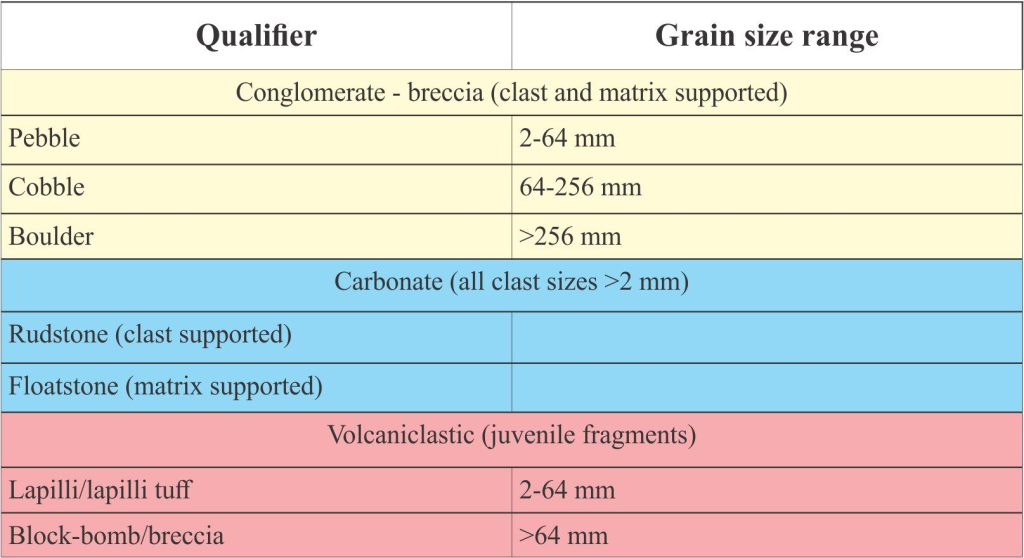

Grain size qualifiers for common rock types. Conglomerate and breccia qualifiers can be used for any lithology, whereas the qualifiers for carbonates and primary volcaniclastic deposits are more specific. The Udden-Wentworth grain size scale is used across all sedimentary lithologies.
Composition
Conglomerates and breccias are composed of large rock fragments. They are derived from pre-existing rocks during exposure to the elements of weathering, erosion, corrosion (chemical change, dissolution), slope failure, and volcanic eruption. Clast composition can be any rock type across the gamut of sedimentary (including older conglomerates), igneous and metamorphic terrains. Lithified gravels are commonly cemented by quartz, clays, and various carbonate minerals, and less commonly by iron oxide and evaporite minerals.
Conglomerate clasts tend to be polymineralic reflecting their original source rock. For example, an andesite clast will contain ferromagnesian minerals such as amphiboles, pyroxenes, and plagioclase phenocrysts, and some groundmass, all with varying degrees of chemical alteration, some of which may be inherited from the volcanic source rock, and some formed during diagenesis. In contrast, sand grains derived from the same rock would include single crystals of the phenocrysts, plus grains that sample the groundmass and counted as lithic fragments. The provenance value of individual sand grains is more ambiguous than is usually encountered with conglomerate clasts.


Rounded and subrounded pebbles and cobbles of andesite. The whole rock, polymineralic composition of each clast is a good representation of their source rock composition. Bar scale (lower left) is 100 mm long.
Hydrodynamic requirements for transport and deposition
We can identify four fundamentally different regimes in which gravel clasts are entrained, transported, and eventually deposited, based primarily on the fluid medium and flow rheology:
- Water flow, or fluidal conditions; this includes the familiar fluvial channel and near-shore – beach environments.
- Terrestrial and subaqueous sediment gravity flows in which fluid viscosity, buoyancy, turbulence, and dispersive pressures from grain-to-grain collisions, are strong determinants of the depositional product (e.g., mobile versus cohesive debris flows, grain flows).
- Pyroclastic density currents, in which the fluid phase is commonly superheated steam and volcanic gas.
- Dry slope failure and rock-face collapse where entrained clasts are not continually immersed in water or sediment-water mixtures. The most common examples of this type of deposit are dry landslides, and talus fans adjacent steep mountain slopes.
Gravels deposited by Newtonian water–fluidal flows
Water that washes shorelines and flows through terrestrial and paralic channels behaves as a Newtonian fluid. Newtonian fluids have negligible shear strength, which means they deform instantly any kind of stress is applied.
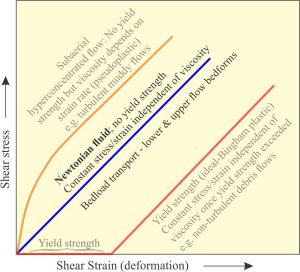

Generalized stress-strain relationships that express the rheological properties of different kinds of Earth fluids involved in sediment entrainment and deposition, focusing here on Newtonian fluids where stress is directly proportional to strain. This means that, in the absence of yield strength, deformation or shear occurs instantly a stress is applied. Modified from Middleton and Wilcock, 1994.
Stand next to a gravelly stream that is in flood (at a safe distance) and you will hear the sound of cobble impacts as they bounce along the bed. Transport of sediment via a traction carpet or suspended load occurs under both Froude subcritical and supercritical conditions. Bedload conditions apply to gravels in much the same way as they do for sandy sediments, except that shear stress over the sediment bed (and therefore velocities) must be greater to initiate (entrain) and maintain clast movement; gravel is rarely moved as a suspended load. In gravel bed river channels, the saltation load is most likely to occur during flood conditions (and probably supercritical flow). These conditions also apply to the wave swash zone on gravel beaches, and to some dilute pyroclastic surges in which turbulence is the dominant flow-supporting mechanism.
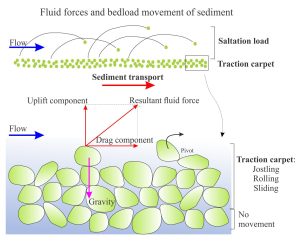

Bedload transport of sediment takes place via a traction carpet at the sediment-water interface and a saltation load, mechanisms that apply to sandy and gravelly deposits. However, entrainment of gravel clasts requires significantly greater shear stress at the bed surface. Small clasts that become wedged between larger clasts will not move until their larger neighbours have been dislodged. Unlike sand where grain movement is relatively continuous, gravel transport along a bed may take place in a series of ‘bursts’. Smaller cobbles and pebbles may saltate under supercritical flow conditions.
Gravels deposited by non-Newtonian flows
Sediment gravity flows consist of solid framework clasts dispersed in a viscous fluid. Fluid viscosity is developed primarily by clay suspensions in water and can vary from highly fluidal and mobile, to ‘goopy’ and sluggish. Viscous fluids have innate strength, called the yield strength, where the fluid will not deform or flow below a critical stress (flow is a manifestation of deformation). Fluids (or solids) that behave in this manner are called plastics, or hydroplastics.
For non-Newtonian fluids, the viscosity will decrease when strain values exceed the yield strength (because yield strength depends on viscosity). If stress is proportional to strain beyond the yield strength (the ideal case) then the material is called a Bingham plastic. The relationship between shear stress and shear strain (deformation) is shown in the diagram below.
You can demonstrate this stress-strain relationship with a simple experiment. Consider a jar of yoghurt. In its unshaken state, place a small, flattish object on the top surface (the object must be denser than the yoghurt, but be sensible – a button, small shell, etc.). If the object is not too heavy it will sit on the surface. In this condition the yoghurt has sufficient strength to prevent it sinking (sinking would be a manifestation of deformation). Remove the object and shake the yoghurt. Gently place the object back on the surface – it will probably sink because the viscosity is now significantly less than its original state (it is more fluid). The yoghurt has behaved as a non-Newtonian fluid.
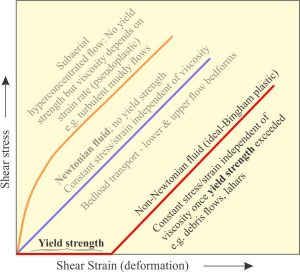

Generalized stress-strain relationships that express the rheological properties of different kinds of Earth fluids involved in sediment entrainment and deposition, focusing here on non-Newtonian fluids that exhibit plastic, or hydroplastic behaviour. All hydroplastic fluids have viscosity-dependent yield strength. Deformation of an ideal plastic or hydroplastic is proportional to stress once the yield strength has been reached (the straight red line segment on the graph). Modified from Middleton and Wilcock, 1994.
Sediment gravity flows generally behave to a greater or lesser extent as hydroplastics. We commonly define two end-member types of debris flow, but acknowledge there are many variations in between:
Debris flows that are predominantly matrix-supported
The classic pebbly mudstone contains clasts dispersed and supported by a muddy matrix (the matrix may also contain sand and small pebbles). These are cohesive flows, where the matrix has sufficient strength to support the framework clasts and the flow itself; turbulence is not involved in clast support.
It is possible for a cohesive debris flow to evolve to a more mobile, less cohesive flow by ingestion of water through the head of the flow. Terrestrial and submarine landslides may transform to cohesive or mobile debris flows (and turbidity currents).
Another set of forces comes to play as the proportion of framework clasts to matrix increases – these are dispersive pressures resulting from clast collisions. Reverse grading of framework clasts is a common manifestation of these mechanics, where there is an increase in clast size towards the top of the flow. Reverse grading may occur at the base of a debris flow or be present throughout the flow.
Reverse grading can be demonstrated in a simple experiment. Fill a jar (not that jar!) with different size beads or small pebbles (dry). Shake the jar gently from side to side – the larger objects will gradually work toward the top of the pile. The larger objects are subjected to more collisions and proportionally higher dispersive pressures.


Left: A classic example of pebbly mudstone from Pigeon Point, California, one of the localities where matrix-supported conglomerates were first described and interpreted as the products of sediment gravity flows. In this example, nearly all the pebbles and cobbles are enveloped in mudstone. The bed represents deposition by a cohesive debris flow. The base of the bed is indicated by a black arrow. The large cobble at lower right was deposited at the top of the underlying bed. Lens cap lower centre is 50 mm diameter. Arrow top right indicates stratigraphic top. Right: Well rounded pebbles of radiolarian chert form a clast-supported framework where there is crude alignment of clast long-axes parallel to bedding, imparting a degree of stratification. This debris flow was probably more mobile than the pebbly mudstone opposite, where clast alignment and stratification indicate shear along the aggrading depositional surface. This type of debris flow is commonly interbedded with more cohesive debris flows. Bar scale in centimetres. Jurassic, Bowser Basin, northern British Columbia.
Debris flows that are predominantly clast-supported
Dilution of the matrix generally results in flows having greater mobility (less cohesive and lower yield strength). Debris flows that contain a high proportion of clast-supported frameworks represent an end member in which shear at the base of the flow results in planar fabrics where elongate clasts are deposited parallel to bedding and may even show imbrication (see the previous image).
There is much variation in matrix viscosity (and yield strength) and framework clast concentrations between the two end-member debris flow types. For example, terrestrial lahars and mud flows can be highly mobile (flow velocities of 10s of kilometres per hour) and capable of transporting vehicle-size blocks – they are very destructive. The more mobile flows commonly are supported by a combination of mud matrix strength, dispersive pressures, and turbulence.
Pyroclastic density currents
Deposits of this type have been described in several posts (linked below). Pyroclastic density current (PDC) is a general term that encompasses all ground-hugging, gravity-driven mixtures of gas and volcaniclastic debris derived from explosive eruptions. Included in this mix are pyroclastic flows, nuée ardentes, ignimbrites, pyroclastic surges and base-surges, and block and ash flows. Flow velocities are commonly several 10s to 100s of km/hour; they tend to be warm (up to 700o C – 1300oF). Flow support mechanisms include dispersive pressures in the more concentrated ignimbrites, turbulence in dilute surge and base-surge type PDCs, fluid pressure (from the superheated steam and gas), and fluidization (produced by incineration of vegetation and vapourised groundwater).
Gravels deposited in dry conditions
This group includes terrestrial landslides, rock falls, and talus fans. In each type, movement of clasts may be lubricated by water, for example along a glide plane, but the rocky material is not immersed in water during transport; interstitial fluids do not participate in the movement of sediment – it’s all driven by gravity in a dry(ish) state. Clasts tend to be highly angular and very poorly sorted; there is little opportunity for reworking. Talus fans may show some degree of down-slope size grading, with the largest fragments at the base of slope.


Part of the mountain rock wall and run-out of Frank Slide, a massive, dry rock slope failure that buried part of the Alberta mining town of Frank in 1903. The failure surface can be seen in the limestone ridge behind. Landslide deposits in the foreground are angular and very poorly sorted. Coal mining may have contributed to weakening of fractured rock along the ridge. Image credit: Marek Ślusarczyk 2007, Wikipedia Commons.
Other posts in this series
Sedimentary lithofacies – An introduction
Ripple lithofacies: Ubiquitous bedforms
Ripple lithofacies influenced by tides
Tabular and trough crossbed lithofacies
Laminated sandstone lithofacies
Low-angle crossbedded sandstone
Hummocky and swaley cross-stratification
Lithofacies beyond supercritical antidunes
Subaqueous dunes influenced by tides
Gravel lithofacies
Crossbedded gravel lithofacies
The lithofacies of mountain streams
